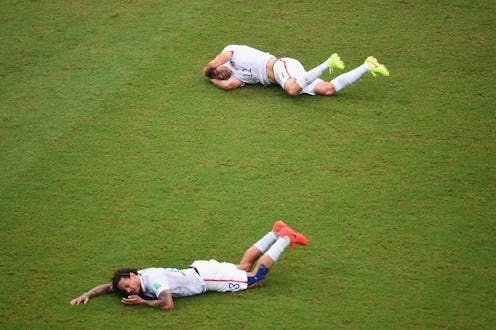News
Soccer Has A Concussion Problem, Too
German-American soccer player Jermaine Jones is known for being a little accident prone. The popular midfielder, currently representing the USA national soccer team, has racked up a number of injuries over the years, ranging from sprained ankles and groin injuries to concussions. In Thursday afternoon's World Cup USA vs. Germany game, Jones harshly collided with fellow USA teammate Alejandro Bedoya. Jones slammed his head against Bedoya's, and swiftly fell to the ground.
Jones ended up with a bloody nose, and both players stayed in the game after being examined by team trainers. However, the seemingly painful collision did raise some questions among soccer spectators: Did Jones endure yet another concussion, and should he have left the game?
Concussions in soccer don't get as much attention as in football or hockey, but they do happen — quite a lot, actually. At the youth level alone, recent reports have shown that high school female soccer players sustain an average of 14 concussions per 10,000 games played — the third-highest concussion rate of all high school sports.
Although there's currently no comprehensive statistics on concussions among professional soccer players, doctors, researchers and even soccer associations are suggesting the rates are growing worse. In 2010, Dr. Robert Cantu, a concussions expert at the Boston University School of Medicine, told Sports Illustrated that the third-highest number of his professional sports patients are soccer players.
In February 2014, the late Patrick Grange became the first soccer player to be diagnosed with chronic traumatic encephalopathy (CTE), a degenerative brain disorder associated with concussions. And just a few months ago, a former Portland Timbers player sued the club for allegedly letting him play while he still had concussion symptoms.
As more reports of the long-lasting effects of concussions come to light, many soccer associations and former professional athletes have been pushing for more regulation — except one.
In a press conference held earlier this week, FIFA officials were mum on the topic of concussions, even when pressed by the media. "We have done everything to manage the concussions accordingly," said Jiri Dvorak, FIFA’s chief medical officer.
FIFA has drew criticism over its meager concussion policy. The association has a "pocket concussion testing tool" for team trainers and also provides medical doctors at the World Cup. However, FIFA officials said in this week's press conference that it's up to each team to decide if they want to use the FIFA doctors and ultimately, the concussion policy. "We can only recommend,” Dvorak said. "We cannot overrule the decision of the team physician."
FIFA's hands-off approach at the 2014 World Cup already has some worried. During the England-Uruguay match last week, Uruguay midfielder Alvaro Pereira was knocked out cold after a collision with an English player. After arguing with the team's trainer, Pereira re-entered the game.
FIFpro, the international soccer player union, immediately criticized FIFA over the incident, calling on the organization to open an investigation on its concussion management:
Football is awash with incidents in which players suffer potentially concussive blows to the head and stay on the pitch. In Pereira's case, he demanded to play on, overruling advice from Uruguay's team physician for him to be immediately substituted. FIFPro understands that in certain moments, faced by the pressures of such an important international stage, many players would react in this way. There are times, however, when the players also require greater protection against the prospect of making any rash decisions.
It's unlikely that FIFA will modify its concussion protocol during the 2014 World Cup. However, it couldn't hurt for the association to take a look at the U.S. Major League Soccer concussion policy, which requires players to sit out games after medical staff suspects they have a concussion. Before returning to play, the athletes must be cleared by the team neuropsychologist.
